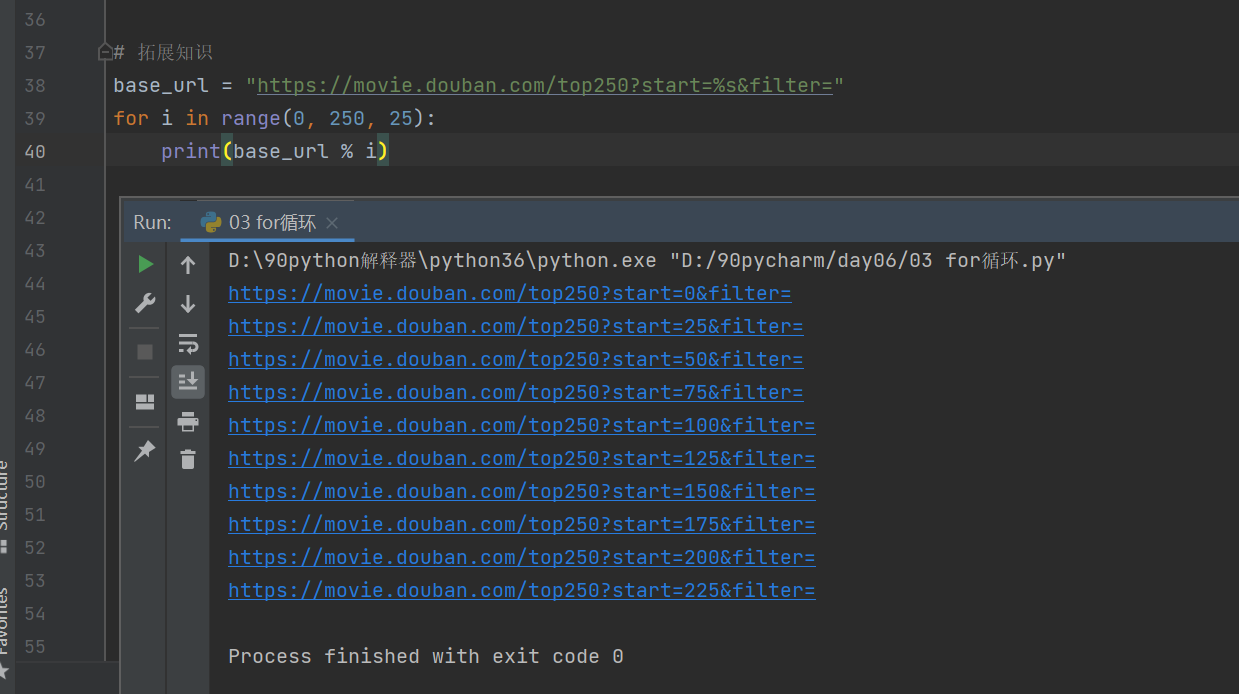Python基础之流程控制-while循环与for循环
目录
一、while+continue
二、while+else
三、死循环
四、for循环
五、range关键字
六、for+break
七、for+continue
八、for+else
九、for循环的嵌套使用
一、while+continue
continue:跳过本次循环,开始下一次循环
# 打印从1-10
count = 1
while count < 11:
print(count)
count += 1
# continue 跳过本次循环,执行下一次循环;continue 会让循环体代码直接回到条件判断处重新判断
# 打印从1-10,跳过5
# 定义起始变量
count = 1
# 循环
while count < 11:
# 当变量等于5
if count == 5:
count += 1
# 直接跳过本次循环,开始下一次循环
continue
# 打印变量值
print(count)
# 变量值自增1
count += 1

二、while+else
else:while循环没有被人为中断(break)的情况下,会执行else
# while+else:
count = 1
while count <6:
print(count)
count += 1
else:
print('嘿嘿嘿')
count += 1
# 被人为中断的情况下不执行else
count = 1
while count < 6:
if count == 4:
break
print(count)
count += 1
else:
print('嘿嘿嘿')


三、死循环
会让CPU极度繁忙甚至崩溃,一直循环不会停下
while True:
print(1)

四、for循环
for循环能实现的功能,while循环都能做到,但是for循环更简洁,并且在循环取值的问题上更方便。
for循环的语法结构:for 变量名 in 可迭代对象:#字符串、列表、字典、元组、集合
for 循环体代码
ps:如果没有合适的变量名,可以使用i/j/k/v/item等等。
1.for循环列表
name_list = ['jason', 'tony', 'kevin', 'lili', 'body']
# 用while循环实现
count = 0
while count < 5:
print(name_list[count])
count += 1
# 用for循环实现
for name in name_list:
print(name)
2.for循环字符串
for i in 'hello':
print(i)
3.for循环字典:默认只能拿到K值
d = {'username': 'jason', 'age': '18', 'height': '189'}
for k in d:
print(k, d[k])



五、range关键字
# 第一种:一个参数,从0开始,顾头不顾尾
for m in range(5):
print(m)
# 第二种:两个参数,自定义起始位置,顾头不顾尾
for m in range(5, 8):
print(m)
# 第三种:三个参数,自定义起始位置,顾头不顾尾,第三个参数是控制等差值
for m in range(2, 10, 2):
print(m)
# 在不同版本的解释器中,range本质不同
在python2.X版本中,range会直接生成列表,xrange是一个迭代器(老母猪)
在python3.X版本中,range是个迭代器(老母猪)
'''可以理解为python2.X版本的xrange就是python3.X版本的range'''
# 拓展知识 : %s:占位符
base_url = "https://movie.douban.com/top250?start=%s&filter="
for i in range(0, 250, 25):
print(base_url % i)


六、for+break
break功能也一样用于结束本层循环
for m in range(20):
if m == 3:
break
print(m)
七、for+continue
continue功能也一样用于结束本层循环执行下一层循环
for m in range(6):
if m == 4:
continue
print(m)

八、for+else
else也一样是for循环结束的情况下才会执行,如果被人为打断一样也不会执行
for m in range(4):
print(m)
else:
print('嘿嘿')
# 当循环被人为中断,则不执行else
for m in range(4):
if m == 2:
break
print(m)
else:
print('嘿嘿')

九、for循环的嵌套使用
for i in range(3):
for j in range(5):
print("*", end='')
print()
# 打印九九乘法表
for i in range(1, 10):
for j in range(1, i+1):
print('%s*%s=%s' % (j, i, j*i), end=' ')
print()





